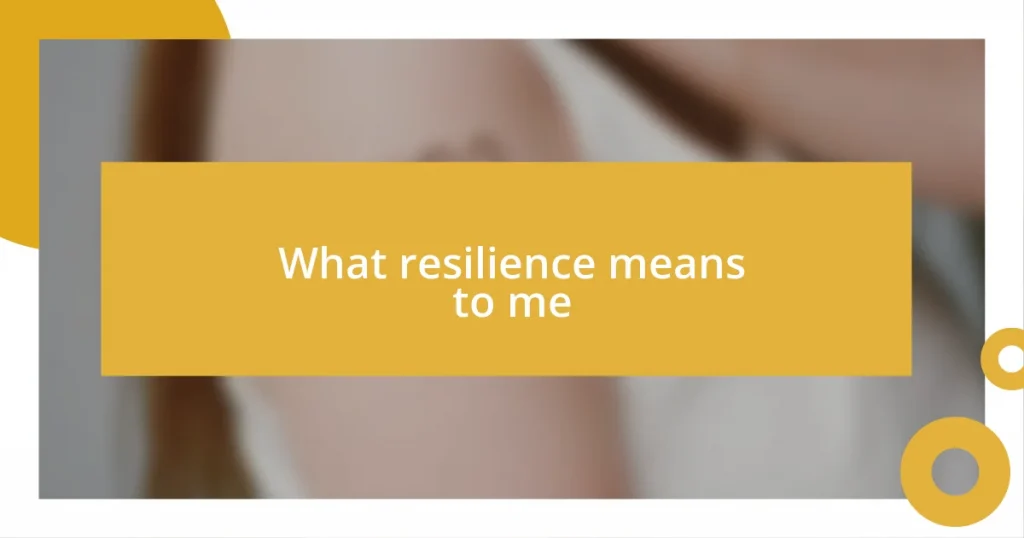Key takeaways:
- Personal resilience strengthens through embracing challenges and learning from setbacks, fostering adaptability and inner strength.
- Key characteristics of resilient individuals include emotional intelligence, optimism, and strong problem-solving skills, which enhance their capacity to navigate adversity.
- Building resilience involves establishing routines, nurturing relationships, and practicing gratitude, all of which contribute to a positive mindset and support system.

Understanding personal resilience
Personal resilience, to me, is like a muscle that you strengthen through life’s challenges. I remember a time when I faced a significant setback at work; instead of giving in to despair, I chose to reflect and analyze the situation. This mindset shift not only helped me recover but also equipped me with tools for future obstacles. How do we build that mental muscle, and can setbacks actually serve as catalysts for growth?
In my experience, resilience often blossoms from vulnerability; it’s about embracing our struggles rather than shying away from them. I think of a difficult family situation where I felt overwhelmed. Yet, by openly discussing my feelings and seeking support, I discovered an unexpected strength within myself. Isn’t it fascinating how our toughest moments can illuminate paths to inner courage?
Another layer of resilience is adaptability, which is essential in navigating life’s unpredictability. I few years back, when my plans went awry due to sudden changes, I felt frustration rising. But I learned to pivot and find new opportunities within those disruptions. This adaptability not only eased my anxiety but also led me to exciting, unforeseen experiences. Have you ever found yourself thriving in chaos? It’s a powerful realization that resilience isn’t just about bouncing back; it’s about moving forward with purpose.

Key characteristics of resilient people
Resilient individuals often display a remarkable level of emotional intelligence. In my own life, I recall a phase when a close friend faced a major life crisis. I stepped up to listen and offer support, which not only helped them cope but also deepened our bond. This experience taught me that understanding and managing emotions—both my own and others’—is vital for navigating tough times. How do you approach supporting loved ones in distress?
Another defining trait of resilient people is their optimism. I remember being part of a challenging project where everything seemed to go wrong. Instead of succumbing to negativity, I encouraged my team to focus on potential solutions rather than the problems at hand. That shift in perspective helped us to tackle each hurdle with renewed determination. Optimism doesn’t imply ignoring reality; it’s about believing we can find a way forward despite obstacles.
Finally, resilient individuals exhibit strong problem-solving skills. I’ve faced situations where the immediate path was unclear, like during a financial setback I encountered some years ago. This challenge pushed me to brainstorm alternatives and explore creative ways to stabilize my situation. I realized that while problems are inevitable, the ability to find practical solutions sets resilient individuals apart from others. Have you ever had to think outside the box to overcome a challenge? That kind of strategic thinking is a powerful ally in building resilience.
| Characteristic | Description |
|---|---|
| Emotional Intelligence | Understanding and managing emotions to navigate challenges effectively. |
| Optimism | Maintaining a positive outlook even in the face of adversity. |
| Problem-Solving Skills | Ability to think critically and find creative solutions to difficulties. |

Building resilience through challenges
Navigating challenges can be incredibly tough, yet I’ve found that embracing those moments is where resilience truly flourishes. I recall a time when I faced a serious health scare. Initially, I felt fear and uncertainty, but as I leaned into the right support and educated myself about my condition, I discovered strength I didn’t know I had. It was a gut-wrenching process, but it taught me to face my fears rather than run from them—and that’s an invaluable lesson in resilience.
Building resilience means being willing to fight through adversity, and I’ve learned to embrace discomfort as a catalyst for growth. Here’s how I see it:
- Face Your Fears: Confronting what scares you can help diminish its power.
- Seek Support: Leaning on friends and family makes the journey less daunting.
- Learn from Setbacks: Every stumble offers a lesson; identifying these can pave the way for future success.
- Practice Self-Reflection: Taking time to analyze experiences can reveal insights that strengthen your resolve.
- Maintain a Growth Mindset: Believe in your ability to learn and adapt through every challenge.
Each of these actions has played a role in how I’ve built my resilience. Life will throw curveballs—how we respond is what truly matters.

Strategies for enhancing resilience
One effective strategy for enhancing resilience is establishing a routine that promotes stability. I remember when I decided to create a morning ritual that included exercise, meditation, and setting daily intentions. This consistent practice grounded me, especially during uncertain times, allowing me to face challenges with a clearer mindset. Have you ever noticed how a simple routine can set the tone for your entire day?
Another valuable approach is cultivating strong relationships with those around you. I’ve found that the more I invest in my connections, the more support I have when life gets tough. There was a period when I organized weekly check-ins with close friends. These moments became a safe haven where we shared not just our ups, but also our downs. This sense of community reinforced my resilience, reminding me I wasn’t alone in my struggles. How do your relationships contribute to your ability to handle adversity?
Lastly, practicing gratitude has profound effects on resilience. I began a gratitude journal after realizing that focusing on what I appreciated helped pivot my mindset during challenging phases. Each evening, I’d jot down three things I was thankful for, no matter how small. Surprisingly, this simple act shifted my perspective from what I lost to what I still had. It’s striking how gratitude can open our eyes to positives, even when everything seems bleak. What small joys could you acknowledge to strengthen your perspective?

Real-life examples of resilience
When I think about resilience, one vivid example comes to mind: my friend’s journey through grief after losing a loved one. Initially, she was overwhelmed by sadness, and I could see the weariness in her eyes. However, as the months went on, she began to commemorate her loved one’s life by organizing charity events in their honor. This not only gave her a purpose but also connected her to a community of support, turning her pain into a source of strength. Have you ever witnessed someone transform their sorrow into a catalyst for positive change?
Another powerful instance of resilience that stands out is during my own experience of job loss. The day I received that email, I felt a deep sense of failure wash over me. Despite the initial shock, I chose to take a step back and re-evaluate my skills and passions. I enrolled in online courses, which not only expanded my knowledge but also reignited my confidence. Through that period of uncertainty, I learned that setbacks can often lead to unexpected opportunities. Isn’t it fascinating how a single moment can shift the trajectory of our lives?
Looking at resilience on a broader scale, I admire the stories of those who have faced natural disasters. One tale that struck me was about a community that lost everything in a flood. Instead of succumbing to despair, they came together to rebuild their homes and support one another. Their determination to rise from the ashes demonstrated the incredible strength of the human spirit. This immense collective effort made me ponder: how often do we underestimate our power to uplift each other during challenging times?

Measuring personal resilience growth
Measuring personal resilience growth can be a deeply personal journey. I remember a time when I started keeping a resilience journal, where I noted the challenges I faced each week and reflected on how I responded. Looking back at those entries, I was able to see not only my progress but also the patterns in how I handled adversity. Have you ever taken the time to reflect on your own responses to difficult situations?
Tracking resilience can be as straightforward as noting small, everyday victories. For instance, I began celebrating moments where I managed to stay calm during stressful circumstances—like handling a tough conversation without losing my cool. Each time I acknowledged these wins, it felt like I was building my resilience muscle. What simple achievements in your life could you recognize to remind yourself of your strength?
Another effective method I discovered is setting specific, measurable goals related to resilience. In one instance, I aimed to incorporate mindfulness practices into my daily routine, committing to just five minutes each morning for a month. Evaluating my emotional responses at the end of that month revealed significant growth—I felt more centered and better equipped to manage stress. How might establishing concrete goals help you track your own resilience journey?














